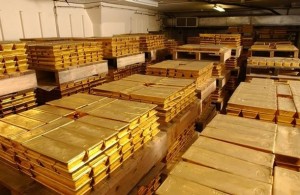 Gold futures were slightly lower during early trade in Europe today, after a massive increase yesterday. The Feds announcement of lower interest rates for a “considerable time” and escalating violence in Iraq pushed havens to multi-month highs, while stocks were also at record highs.
Gold futures were slightly lower during early trade in Europe today, after a massive increase yesterday. The Feds announcement of lower interest rates for a “considerable time” and escalating violence in Iraq pushed havens to multi-month highs, while stocks were also at record highs.
Gold futures for delivery in August traded for $1 308.9 per troy ounce at 7:50 GMT on the COMEX in New York today, down 0.40%. Daily high and low stood at $1 322.5 and $1 307.5 per troy ounce, respectively, reaching a two-month peak. Yesterday the contract added 3.25%, and so far this week gold has added more than 3%.
Meanwhile, silver contracts for July stood at $20.620 per troy ounce, for a drop of 0.14%. Daily high and low were at $20.850 and $20.585 per troy ounce, respectively. Yesterday the contract added 4.40%, reaching a three-month high at $20.925 per troy ounce, and so far this week silver has gained about 5%.
“Gold has been helped higher by the Fed’s guidance on interest rates, as well as geopolitical issues around Iraq and Ukraine,” Sun Yonggang, macroeconomic strategist at Everbright Futures Co., said for Bloomberg. “The ascent was aided by technical buying after prices rose above the various moving averages and past the psychological $1,300 mark. It won’t be surprising to see a bit of selling today after the rally.”
Iraq
Sunni militants, led by a group of extremists called ISIS (Islamic State in Iraq and the Levant), continued fighting security forces in many towns in the northern and western provinces of the country. Fighting was also reported at Iraq’s largest oil refinery at Baiji, which supplies 40% of Iraqi domestic fuel demand. Some 30 000 people, who work at the refinery had been evacuated earlier.
“The south of the country is not beyond the geographic reach of extremist groups seeking to undermine the government,” analysts at Barclays said in a note, cited by Bloomberg. “We believe that any significant uptick in unrest in the south, even if oil facilities were spared, would likely accelerate the exodus of foreign oil workers out the country.”
Yesterday authorities had assured that the military were in control of the refinery, and that the militants were being pushed back. The government also insisted insurgents do not threaten Baghdad, nor the southern oilfields, which account for 90% of Iraqi oil output.
Iraq is OPEC’s second-top oil producer, and exports some 3 million barrels per day from its main southern terminal at Basra.
FOMC meeting
The US Federal Open Market Committee (FOMC) announced key monetary policy decisions yesterday, after concluding its 2-day meeting. Interest rate was kept at 0.25%, while monthly assets purchases were trimmed by $10bn for the fifth straight time. Fed’s Chair Janet Yellen expressed the Committee’s views that rates are likely to stay low “for a considerable time”. Yellen emphasized on labor market weaknesses and “noisy data”, referring to improving CPI readings.
“All the evidence is that this is the weakest economic recovery on record, so she is going to tilt the committee in the direction of providing as much aid as possible for as long as it takes,” Chris Rupkey, chief financial economist at Bank of Tokyo-Mitsubishi UFJ Ltd. in New York, said for Bloomberg.
FOMC’s decisions have a significant impact on financial markets, as rates dictate short-term dollar valuation trends. Also, the US stimulus program, which buys assets worth tens of billions of dollars each month, has been a sizable support to the economy, and a cutback would mean less “easy” business. However, the cutbacks are implemented only as the economy recovers well enough.
Stocks, dollar
US stocks added on the Fed’s commitment to supporting the economy. S&P 500 added 0.13% during Thursdays Wall Street session, for the record-high closing level of 1959.48. Dow 30 was up 0.09%, while Nasdaq 100 closed for a daily loss of 0.10%. DJ Euro Stoxx 50 added 1.08% yesterday, and by 7:22 GMT today was down by 0.13%.
Meanwhile, assets at the SPDR Gold Trust – the largest gold-backed exchange-traded fund, were unchanged yesterday at 782.62 tons, having dropped more than 4 tons this week. The fund is orbiting multi-year lows, amid a recovering US economy.
The US Dollar Index, which measure the greenback’s performance against six other major currencies, was pressured by the Fed’s firm tone on keeping rates lower for as long as necessary. The gauge has dropped 0.4% over the previous four sessions, and by 7:25 GMT today was down a further 0.03% at 80.37.
Meanwhile, the euro, the dollar’s main competitor, has gained more than 0.5% against the dollar this week, and by 7:27 GMT today was up by a further 0.01% at 1.3612 EUR/USD.
US data
The US posted several economic readings yesterday. Initial applications for unemployment benefits for the week ended June 14 were logged at 312 000, beating expectations and improving on the 317 000 for the previous week. Meanwhile, continuing claims for the week through June 7 were also better than expected at 2.561 million, which is the lowest reading since October 2007.
“The trend in initial claims is good,” Ryan Sweet, senior economist at Moody’s Analytics Inc. in West Chester, Pennsylvania, said for Bloomberg before the report. “The job market continues to heal.”
Philadelphia Fed Manufacturing Index for June was also revealed on Thursday. The figure was logged at 17.8, beating expectations and improving on May’s 15.4 reading.
Previously, the US posted key economic data this week. CPI for May was recorded at 2.1% annual growth and 0.4% month-on-month, while core CPI, which exclude food and energy, added 0.3% on a monthly basis and 2.0% year-on-year. CPI is a leading indicator for consumer spending, which generates about 80% of US GDP, and is the primary gauge used by the Fed for its monetary policy decisions.
US housing data was also released this week. The annualized rate of housing starts dropped 6.5% on a monthly basis in May and stand at 1.001 million, while building permits’ annualized rate declined by 6.4% on a monthly basis to 0.991 million. The real estate sector accounts for about 13% of US GDP.
Technical view
According to Binary Tribune’s daily analysis, in case Gold August futures on the COMEX manage to breach the first resistance level at $1 332.0, the contract will probably continue up to test $1 349.9. In case the second key resistance is broken, the precious metal will likely attempt to advance to $1 377.8.
If the contract manages to breach the first key support at $1 286.2, it will probably continue to slide and test $1 258.3. With this second key support broken, the movement to the downside may extend to $1 240.4.
Meanwhile, silver futures for July will see their first resistance level at $21.105. If it is breached, the contract will meet next resistance at $21.563, and then the third level at $22.200.
Silver will find its first support point at $20.010. Should it be breached, the second level of support is estimated at $19.373 and the third at $18.915.





